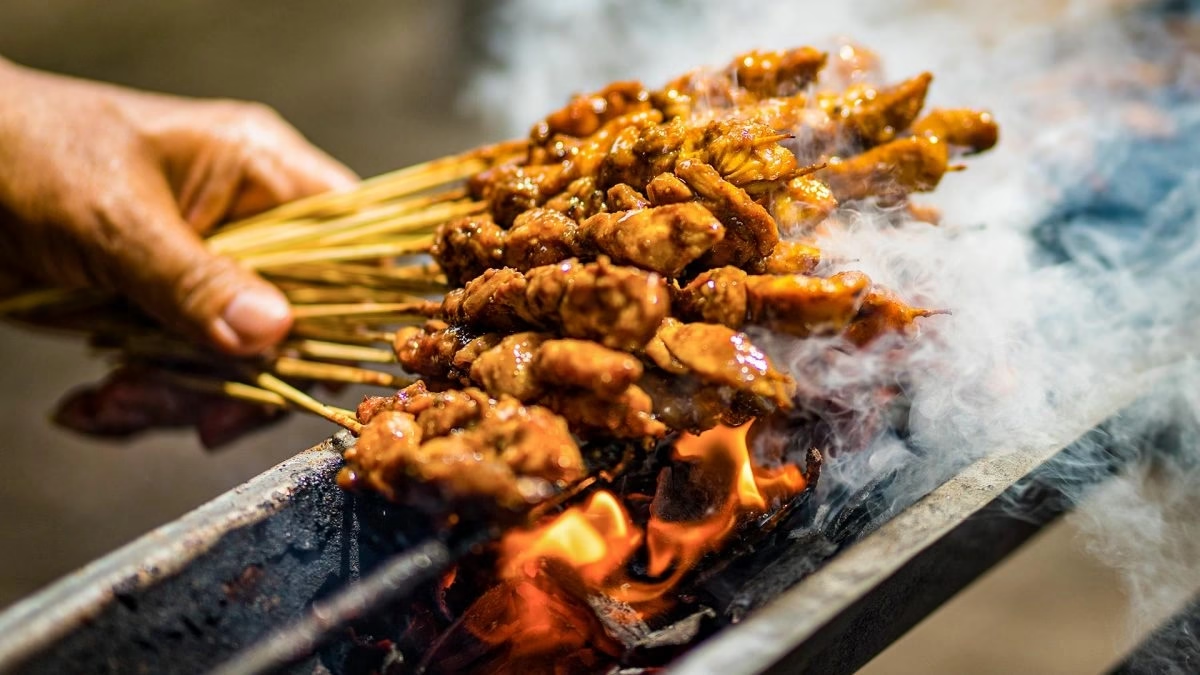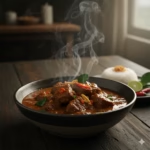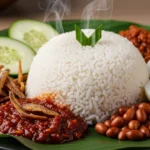Satay

Satay is a Southeast Asian dish of seasoned, grilled meat, seafood, or vegetables on a skewer, usually served with a peanut sauce. It originated in Indonesia and is popular in countries like Thailand and Malaysia, with regional variations in flavor and ingredients.
Satay is a traditional dish originating from Java, Indonesia, consisting of seasoned, skewered, and grilled meat, typically served with a peanut sauce.
Satay, a dish of humble origins that has become a global culinary icon, is more than just a simple snack on a stick. It’s a symphony of flavors—savory, sweet, and nutty—that tells a story of cultural fusion and community. From the bustling streets of Southeast Asia to modern kitchens around the world, satay embodies the art of grilling and the joy of shared meals. This article will explore everything you need to know about this beloved dish, from its deep history to its delicious details.
Origin
Satay, or sate in its native tongue, is a dish with deep roots in Java, Indonesia. Its creation is widely attributed to 19th-century Javanese street vendors who adapted the classic kebabs introduced by Indian and Arab traders. From its birthplace on the island of Java, this culinary innovation spread throughout Indonesia and into neighboring Southeast Asian countries, evolving with each new region.
Category
Satay falls into the category of skewered and grilled meat dishes. It is a quintessential street food, a popular appetizer, and a staple at both casual eateries and formal dining establishments across Southeast Asia.
Types of Satay in Malaysia
| Type | Main Ingredient | Origin / Popular Region | Description |
|---|---|---|---|
| Satay Kajang | Chicken, beef, lamb | Kajang, Selangor | The most famous Malaysian satay variety; thick, juicy meat chunks grilled on skewers, served with rich peanut sauce and nasi impit (compressed rice). |
| Satay Haji Samuri | Chicken, beef, deer | Kajang | A signature brand from Kajang offering a balanced sweet-spicy flavor, often considered the benchmark for authentic satay. |
| Satay Kelantan | Chicken, beef | Kelantan | Sweeter and lighter; marinated with coconut milk, turmeric, and sugar, often served with rice cubes and a mild peanut gravy. |
| Satay Madura (Malay-Indonesian influence) | Chicken, mutton | Johor | Influenced by Javanese settlers; slightly smoky flavor with dark, soy-based marinade and thick sauce. |
| Satay Padang (Minangkabau influence) | Beef, tongue | Negeri Sembilan | Unique yellow gravy made from rice flour, turmeric, and coconut milk — distinct from typical peanut sauce. |
| Satay Perut | Beef tripe | Kelantan, Terengganu | Made from cow tripe marinated and grilled; chewy texture, often eaten as a specialty snack. |
| Satay Ikan (Fish Satay) | Mackerel or tenggiri | Terengganu | Coastal specialty; minced fish mixed with spices, wrapped on sticks, and grilled — similar to otak-otak but drier. |
| Satay Lembu (Beef Satay) | Beef | Nationwide | Popular for its robust flavor; marinated with lemongrass, coriander, and turmeric, grilled to smoky perfection. |
| Satay Ayam (Chicken Satay) | Chicken | Nationwide | The most common type; tender, aromatic, and served with peanut sauce, cucumber, and onions. |
| Satay Kambing (Mutton Satay) | Mutton | Selangor, Penang | Rich, gamey taste with aromatic spices; often served with spicy sambal peanut sauce. |
| Satay Arnab (Rabbit Satay) | Rabbit | Pahang, rural regions | A lean and tender alternative; mild flavor with coconut milk-based marinade. |
| Satay Rusa (Venison Satay) | Deer | Pahang, Perak | Premium version; lean, slightly sweet meat with deep, smoky flavor. |
| Satay Daging (Dried Beef Satay) | Dried beef slices | Kelantan | Thin beef slices dried and grilled; sweet-spicy glaze, eaten as snack during Hari Raya. |
| Satay Lok Lok | Mixed meats, seafood, vegetables | Penang | Street-style satay where skewers are dipped into boiling broth or peanut sauce — a hotpot-satay hybrid. |
Appearance
A typical serving of satay consists of small, bite-sized pieces of meat threaded onto slender skewers, often made of bamboo. After grilling, the meat takes on a beautiful golden-brown color with distinct grill marks and a slight char. It is characteristically served with a rich, dark brown peanut dipping sauce.
Ingredients
The core components of satay are the meat, the marinade, and the dipping sauce. Common meats include chicken (Sate Ayam), beef (Sate Sapi), and lamb (Sate Kambing). The marinade is a fragrant blend of spices such as turmeric, coriander, cumin, lemongrass, and sweet soy sauce. The famous accompanying sauce is a thick, savory-sweet peanut sauce made from ground peanuts, coconut milk, and various seasonings.
Preparation
The process begins with marinating the meat for several hours to infuse it with flavor. The seasoned meat is then threaded onto skewers and grilled over a charcoal fire. This traditional method imparts a signature smoky flavor. Simultaneously, the peanut sauce is prepared by simmering a paste of spices and peanuts until it reaches a thick, creamy consistency.
Equipment
Essential equipment includes skewers, a charcoal grill (for that authentic smoky taste), and a saucepan for the dipping sauce.
Variations
Satay’s versatility has led to a myriad of variations. From the sweet and savory Sate Madura and the thick, spicy Sate Padang in Indonesia, to the Balinese Sate Lilit made with minced fish wrapped around a lemongrass skewer, each region offers a unique take on the classic.
Taste
Satay offers a complex flavor profile. The grilled meat is savory and often slightly sweet from the marinade, while the peanut sauce adds a rich, nutty, and sometimes spicy dimension. Fresh garnishes like cucumber and onion provide a crisp, refreshing contrast.
Texture
The texture is a satisfying mix of tender and juicy meat with a slight char on the outside. The peanut sauce is thick and creamy, coating the skewers well, while the accompanying rice cakes are dense and chewy.
Aroma
The aroma of satay is a feast for the senses. The smoky scent from the charcoal grill mingles with the fragrant spices of the marinade and the deep, nutty fragrance of the peanut sauce, creating an unforgettable and mouth-watering scent.
Sound
The cooking process is marked by the distinct sizzle of meat hitting the hot grill and the gentle crackle of the charcoal. When enjoyed, you might hear a slight crunch from the charred bits and the satisfying sound of dipping.
Cultural Significance
Satay holds a significant place in the cultural fabric of Indonesia and Malaysia. It is considered a national dish in both countries and is a staple at celebrations, festivals, and social gatherings, symbolizing hospitality and togetherness.
Symbolism
The dish symbolizes the fusion of different cultures, particularly the blend of indigenous Southeast Asian flavors with Middle Eastern and Indian culinary traditions. Its humble origins as a street food also represent accessibility and a communal way of eating.
Regional Cuisine
While Indonesian in origin, satay has been embraced by the regional cuisines of Malaysia, Singapore, and Thailand. Each country has developed its own distinctive style, from the Malaysian version with its sweeter peanut sauce to the Thai version often served with a cucumber relish.
Social Context
Satay is a quintessential social food. It is often enjoyed in groups at bustling street food stalls, food courts, and family barbecues, fostering a sense of community and shared experience.
Nutritional Information
The nutritional content of satay varies. While a good source of lean protein, the calorie and fat content can be high, particularly from the rich peanut sauce.
Health Benefits
Satay can offer health benefits, including being a great source of protein. The spices in the marinade, such as turmeric, also contain anti-inflammatory and antioxidant properties.
Dietary Restrictions
Vegetarian and vegan versions of satay, using tofu or tempeh, are widely available. However, due to the presence of peanut sauce, those with peanut allergies must exercise caution.
Allergens
The primary allergen is peanuts, which are the main ingredient in the dipping sauce.
Cost
Satay is generally an affordable food, accessible to all. Its cost is low at street food stalls and higher in restaurants.
Production
Satay is produced by marinating, skewering, and grilling the meat. Traditional methods involve grilling over charcoal, but modern kitchens use gas grills for convenience.
Sustainability
The sustainability of satay production depends on the sourcing of meat and other ingredients. Local and responsibly sourced components contribute to a more sustainable practice.
Availability
Satay is widely available throughout Southeast Asia and can be found in many Asian restaurants and markets globally, reflecting its international popularity.
History
The history of satay is a story of culinary migration and adaptation. It began as a street food in 19th-century Java, evolving from foreign influences into a dish that is distinctly Southeast Asian.
Anecdotes
Many stories revolve around the dedicated satay vendors who carry their portable grills on their shoulders, a traditional sight that still persists and evokes a sense of nostalgia.
How to Make Authentic Chicken Satay
Making satay at home is a rewarding experience that fills your kitchen with the rich, smoky, and fragrant aromas of Southeast Asia. This recipe provides a comprehensive guide to crafting the classic chicken satay skewers and the essential peanut dipping sauce from scratch.
- Yields: 4 servings (approx. 16 skewers)
- Prep time: 30 minutes
- Marinating time: 1 hour to overnight
- Cook time: 10-15 minutes
Part 1: The Chicken Satay Skewers
The key to a perfect skewer is a well-balanced marinade that infuses the meat with flavor and a proper grilling technique that creates a juicy, tender interior and a slightly charred exterior.
Ingredients
- 2 lbs (approx. 1 kg) boneless, skinless chicken thighs or breasts
- 16-20 bamboo skewers
For the Marinade:
- 1 tbsp ground coriander
- 1 tbsp ground turmeric
- 1 tsp ground cumin
- 1 tsp ground ginger
- 3 cloves garlic, minced
- 2 tbsp sweet soy sauce (kecap manis)
- 1 tbsp lime juice
- 1 tbsp vegetable or coconut oil
- ½ tsp salt
- ¼ tsp white pepper
Preparation
- Prepare the Skewers: If using bamboo skewers, soak them in water for at least 30 minutes. This prevents them from burning on the grill.
- Cut the Chicken: Cut the chicken into uniform, bite-sized cubes, about 1-inch in size. This ensures even cooking.
- Make the Marinade: In a large bowl, whisk together all the marinade ingredients until well combined.
- Marinate the Chicken: Add the chicken pieces to the marinade bowl and toss until every piece is evenly coated. Cover the bowl and refrigerate for at least 1 hour, or for a more intense flavor, let it marinate overnight.
- Skewer the Chicken: Thread the marinated chicken pieces onto the soaked skewers. Arrange the pieces so they are snug but not tightly packed, leaving a small space between them to allow for even grilling.
Part 2: The Peanut Dipping Sauce
This thick, creamy, and flavorful peanut sauce is the heart of the satay experience.
Ingredients
- 1 tbsp cooking oil
- 2 cloves garlic, minced
- 1 small shallot, finely chopped
- 1 cup creamy peanut butter
- 1 cup coconut milk (full-fat)
- 3 tbsp sweet soy sauce (kecap manis)
- 2 tbsp brown sugar or palm sugar
- 1 tbsp lime juice
- 1 tbsp tamarind paste (optional, for a tangy note)
- 1 tsp chili flakes or 1 tsp red curry paste (adjust to taste)
- ½ tsp salt
- Water, as needed for consistency
Preparation
- Sauté Aromatics: In a small saucepan, heat the oil over medium heat. Add the minced garlic and shallot, and sauté until fragrant, about 1-2 minutes.
- Combine Ingredients: Add the peanut butter, coconut milk, sweet soy sauce, brown sugar, chili flakes (or curry paste), and salt to the saucepan. Stir continuously with a whisk or wooden spoon until the peanut butter melts and all ingredients are smoothly combined.
- Simmer and Thicken: Bring the sauce to a gentle simmer, stirring constantly to prevent it from sticking to the bottom. Cook for 5-7 minutes, or until the sauce thickens to your desired consistency. If it becomes too thick, add a little water, 1 tablespoon at a time, until it’s a creamy, pourable consistency.
- Finish the Sauce: Remove the saucepan from the heat. Stir in the lime juice and tamarind paste (if using). Taste and adjust seasoning with more sugar, salt, or chili as needed. The sauce can be served warm or at room temperature.
Part 3: Grilling and Serving
This is where the flavors come alive. The smoky char from the grill is what makes satay truly special.
Instructions
- Preheat the Grill: Heat a charcoal grill to medium-high heat. If using a gas grill or an indoor grill pan, preheat it to a similar temperature.
- Grill the Skewers: Lightly brush the grill grates with oil to prevent sticking. Place the skewers on the grill, ensuring they are not overcrowded.
- Cook and Baste: Grill the chicken for 2-3 minutes per side, turning them regularly. For an authentic touch, you can baste the skewers with any leftover marinade during the last few minutes of grilling. The chicken is cooked when it is lightly charred and the juices run clear.
- Serve: Transfer the hot, grilled satay to a platter. Serve immediately with a bowl of the warm peanut sauce and traditional accompaniments like sliced cucumbers, red onions, and rice cakes (ketupat).
Enjoy your homemade satay feast!
Famous Restaurant to Try
Haji Samuri Satay (Kajang)
Address: Jalan Kelab, Bandar Kajang, 43000 Kajang, Selangor, Malaysia
Hours:
Open ⋅ Closes 10:30 pm
Phone: +60 3-8737 1853
Order: foodpanda.my
Which country is satay famous in?
Satay is widely consumed across Indonesia, Malaysia, Singapore, Brunei, Thailand and the southern Philippines, where it forms part of everyday meals, street food and festive occasions.
Discover Kuih Lapis Sarawak, a traditional multi-layered Malaysian dessert from Sarawak.…
Experience Nasi Lemak, Malaysia’s national dish — fragrant coconut rice with…
Discover Cucur Udang, Malaysia’s iconic prawn fritter — crispy, golden, and…
Discover the authentic taste of Ikan Patin Masak Tempoyak, a traditional…
Satay is a simple dish can become a powerful symbol of a nation’s culinary identity and a source of shared joy.
Whether you’re a first-time taster or a lifelong lover, each skewer offers a delicious journey through Southeast Asia’s vibrant flavors.
So next time you see that unmistakable plume of smoke and smell the fragrant aroma of grilling meat, remember you’re not just about to eat; you’re about to experience a piece of history on a stick.











Comments are closed.